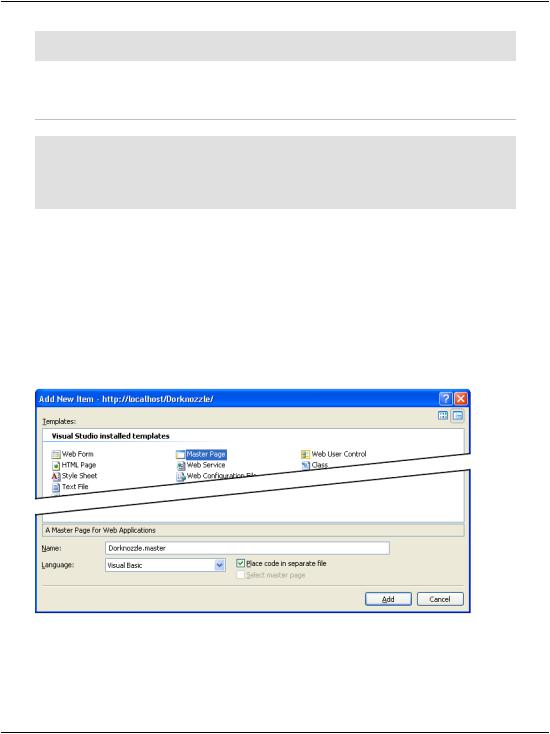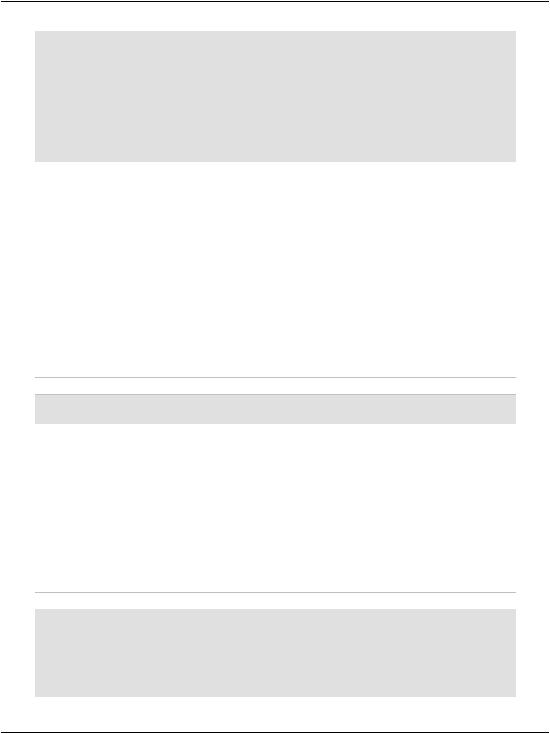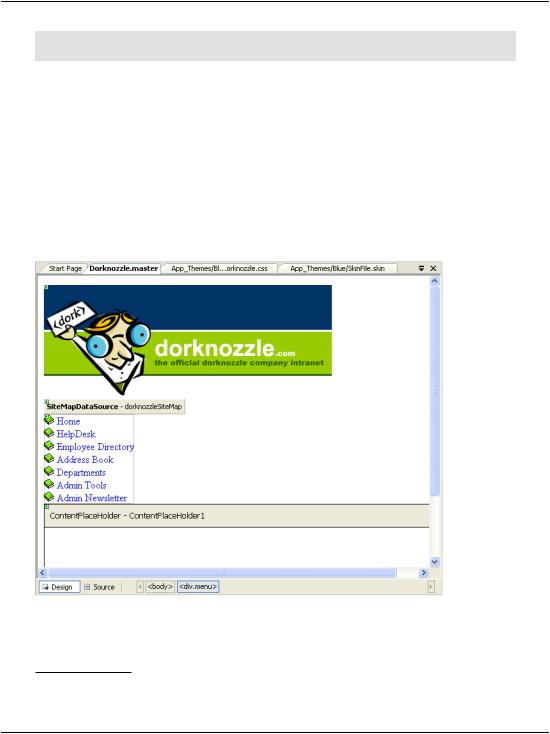
- •Table of Contents
- •Preface
- •What is ASP.NET?
- •Installing the Required Software
- •Installing the Web Server
- •Installing Internet Information Services (IIS)
- •Installing Cassini
- •Installing the .NET Framework and the SDK
- •Installing the .NET Framework
- •Installing the SDK
- •Configuring the Web Server
- •Configuring IIS
- •Configuring Cassini
- •Where do I Put my Files?
- •Using localhost
- •Virtual Directories
- •Using Cassini
- •Installing SQL Server 2005 Express Edition
- •Installing SQL Server Management Studio Express
- •Installing Visual Web Developer 2005
- •Writing your First ASP.NET Page
- •Getting Help
- •Summary
- •ASP.NET Basics
- •ASP.NET Page Structure
- •Directives
- •Code Declaration Blocks
- •Comments in VB and C# Code
- •Code Render Blocks
- •ASP.NET Server Controls
- •Server-side Comments
- •Literal Text and HTML Tags
- •View State
- •Working with Directives
- •ASP.NET Languages
- •Visual Basic
- •Summary
- •VB and C# Programming Basics
- •Programming Basics
- •Control Events and Subroutines
- •Page Events
- •Variables and Variable Declaration
- •Arrays
- •Functions
- •Operators
- •Breaking Long Lines of Code
- •Conditional Logic
- •Loops
- •Object Oriented Programming Concepts
- •Objects and Classes
- •Properties
- •Methods
- •Classes
- •Constructors
- •Scope
- •Events
- •Understanding Inheritance
- •Objects In .NET
- •Namespaces
- •Using Code-behind Files
- •Summary
- •Constructing ASP.NET Web Pages
- •Web Forms
- •HTML Server Controls
- •Using the HTML Server Controls
- •Web Server Controls
- •Standard Web Server Controls
- •Label
- •Literal
- •TextBox
- •HiddenField
- •Button
- •ImageButton
- •LinkButton
- •HyperLink
- •CheckBox
- •RadioButton
- •Image
- •ImageMap
- •PlaceHolder
- •Panel
- •List Controls
- •DropDownList
- •ListBox
- •RadioButtonList
- •CheckBoxList
- •BulletedList
- •Advanced Controls
- •Calendar
- •AdRotator
- •TreeView
- •SiteMapPath
- •Menu
- •MultiView
- •Wizard
- •FileUpload
- •Web User Controls
- •Creating a Web User Control
- •Using the Web User Control
- •Master Pages
- •Using Cascading Style Sheets (CSS)
- •Types of Styles and Style Sheets
- •Style Properties
- •The CssClass Property
- •Summary
- •Building Web Applications
- •Introducing the Dorknozzle Project
- •Using Visual Web Developer
- •Meeting the Features
- •The Solution Explorer
- •The Web Forms Designer
- •The Code Editor
- •IntelliSense
- •The Toolbox
- •The Properties Window
- •Executing your Project
- •Using Visual Web Developer’s Built-in Web Server
- •Using IIS
- •Using IIS with Visual Web Developer
- •Core Web Application Features
- •Web.config
- •Global.asax
- •Using Application State
- •Working with User Sessions
- •Using the Cache Object
- •Using Cookies
- •Starting the Dorknozzle Project
- •Preparing the Sitemap
- •Using Themes, Skins, and Styles
- •Creating a New Theme Folder
- •Creating a New Style Sheet
- •Styling Web Server Controls
- •Adding a Skin
- •Applying the Theme
- •Building the Master Page
- •Using the Master Page
- •Extending Dorknozzle
- •Debugging and Error Handling
- •Debugging with Visual Web Developer
- •Other Kinds of Errors
- •Custom Errors
- •Handling Exceptions Locally
- •Summary
- •Using the Validation Controls
- •Enforcing Validation on the Server
- •Using Validation Controls
- •RequiredFieldValidator
- •CompareValidator
- •RangeValidator
- •ValidationSummary
- •RegularExpressionValidator
- •Some Useful Regular Expressions
- •CustomValidator
- •Validation Groups
- •Updating Dorknozzle
- •Summary
- •What is a Database?
- •Creating your First Database
- •Creating a New Database Using Visual Web Developer
- •Creating Database Tables
- •Data Types
- •Column Properties
- •Primary Keys
- •Creating the Employees Table
- •Creating the Remaining Tables
- •Executing SQL Scripts
- •Populating the Data Tables
- •Relational Database Design Concepts
- •Foreign Keys
- •Using Database Diagrams
- •Diagrams and Table Relationships
- •One-to-one Relationships
- •One-to-many Relationships
- •Many-to-many Relationships
- •Summary
- •Speaking SQL
- •Reading Data from a Single Table
- •Using the SELECT Statement
- •Selecting Certain Fields
- •Selecting Unique Data with DISTINCT
- •Row Filtering with WHERE
- •Selecting Ranges of Values with BETWEEN
- •Matching Patterns with LIKE
- •Using the IN Operator
- •Sorting Results Using ORDER BY
- •Limiting the Number of Results with TOP
- •Reading Data from Multiple Tables
- •Subqueries
- •Table Joins
- •Expressions and Operators
- •Transact-SQL Functions
- •Arithmetic Functions
- •String Functions
- •Date and Time Functions
- •Working with Groups of Values
- •The COUNT Function
- •Grouping Records Using GROUP BY
- •Filtering Groups Using HAVING
- •The SUM, AVG, MIN, and MAX Functions
- •Updating Existing Data
- •The INSERT Statement
- •The UPDATE Statement
- •The DELETE Statement
- •Stored Procedures
- •Summary
- •Introducing ADO.NET
- •Importing the SqlClient Namespace
- •Defining the Database Connection
- •Preparing the Command
- •Executing the Command
- •Setting up Database Authentication
- •Reading the Data
- •Using Parameters with Queries
- •Bulletproofing Data Access Code
- •Using the Repeater Control
- •More Data Binding
- •Inserting Records
- •Updating Records
- •Deleting Records
- •Using Stored Procedures
- •Summary
- •DataList Basics
- •Handling DataList Events
- •Editing DataList Items and Using Templates
- •DataList and Visual Web Developer
- •Styling the DataList
- •Summary
- •Using the GridView Control
- •Customizing the GridView Columns
- •Styling the GridView with Templates, Skins, and CSS
- •Selecting Grid Records
- •Using the DetailsView Control
- •Styling the DetailsView
- •GridView and DetailsView Events
- •Entering Edit Mode
- •Using Templates
- •Updating DetailsView Records
- •Summary
- •Advanced Data Access
- •Using Data Source Controls
- •Binding the GridView to a SqlDataSource
- •Binding the DetailsView to a SqlDataSource
- •Displaying Lists in DetailsView
- •More on SqlDataSource
- •Working with Data Sets and Data Tables
- •What is a Data Set Made From?
- •Binding DataSets to Controls
- •Implementing Paging
- •Storing Data Sets in View State
- •Implementing Sorting
- •Filtering Data
- •Updating a Database from a Modified DataSet
- •Summary
- •Security and User Authentication
- •Basic Security Guidelines
- •Securing ASP.NET 2.0 Applications
- •Working with Forms Authentication
- •Authenticating Users
- •Working with Hard-coded User Accounts
- •Configuring Forms Authentication
- •Configuring Forms Authorization
- •Storing Users in Web.config
- •Hashing Passwords
- •Logging Users Out
- •ASP.NET 2.0 Memberships and Roles
- •Creating the Membership Data Structures
- •Using your Database to Store Membership Data
- •Using the ASP.NET Web Site Configuration Tool
- •Creating Users and Roles
- •Changing Password Strength Requirements
- •Securing your Web Application
- •Using the ASP.NET Login Controls
- •Authenticating Users
- •Customizing User Display
- •Summary
- •Working with Files and Email
- •Writing and Reading Text Files
- •Setting Up Security
- •Writing Content to a Text File
- •Reading Content from a Text File
- •Accessing Directories and Directory Information
- •Working with Directory and File Paths
- •Uploading Files
- •Sending Email with ASP.NET
- •Configuring the SMTP Server
- •Sending a Test Email
- •Creating the Company Newsletter Page
- •Summary
- •The WebControl Class
- •Properties
- •Methods
- •Standard Web Controls
- •AdRotator
- •Properties
- •Events
- •BulletedList
- •Properties
- •Events
- •Button
- •Properties
- •Events
- •Calendar
- •Properties
- •Events
- •CheckBox
- •Properties
- •Events
- •CheckBoxList
- •Properties
- •Events
- •DropDownList
- •Properties
- •Events
- •FileUpload
- •Properties
- •Methods
- •HiddenField
- •Properties
- •HyperLink
- •Properties
- •Image
- •Properties
- •ImageButton
- •Properties
- •Events
- •ImageMap
- •Properties
- •Events
- •Label
- •Properties
- •LinkButton
- •Properties
- •Events
- •ListBox
- •Properties
- •Events
- •Literal
- •Properties
- •MultiView
- •Properties
- •Methods
- •Events
- •Panel
- •Properties
- •PlaceHolder
- •Properties
- •RadioButton
- •Properties
- •Events
- •RadioButtonList
- •Properties
- •Events
- •TextBox
- •Properties
- •Events
- •Properties
- •Validation Controls
- •CompareValidator
- •Properties
- •Methods
- •CustomValidator
- •Methods
- •Events
- •RangeValidator
- •Properties
- •Methods
- •RegularExpressionValidator
- •Properties
- •Methods
- •RequiredFieldValidator
- •Properties
- •Methods
- •ValidationSummary
- •Properties
- •Navigation Web Controls
- •SiteMapPath
- •Properties
- •Methods
- •Events
- •Menu
- •Properties
- •Methods
- •Events
- •TreeView
- •Properties
- •Methods
- •Events
- •HTML Server Controls
- •HtmlAnchor Control
- •Properties
- •Events
- •HtmlButton Control
- •Properties
- •Events
- •HtmlForm Control
- •Properties
- •HtmlGeneric Control
- •Properties
- •HtmlImage Control
- •Properties
- •HtmlInputButton Control
- •Properties
- •Events
- •HtmlInputCheckBox Control
- •Properties
- •Events
- •HtmlInputFile Control
- •Properties
- •HtmlInputHidden Control
- •Properties
- •HtmlInputImage Control
- •Properties
- •Events
- •HtmlInputRadioButton Control
- •Properties
- •Events
- •HtmlInputText Control
- •Properties
- •Events
- •HtmlSelect Control
- •Properties
- •Events
- •HtmlTable Control
- •Properties
- •HtmlTableCell Control
- •Properties
- •HtmlTableRow Control
- •Properties
- •HtmlTextArea Control
- •Properties
- •Events
- •Index

Building the Master Page
</namespaces>
</pages>
If you’re using C#, you’ll need to add the pages element to the system.web element yourself:
File: Web.config (excerpt)
<system.web>
<pages theme="Blue" />
</system.web>
Building the Master Page
This is where the real fun begins! All of the pages in Dorknozzle have a common structure, with the same header on the top, and the same menu on the left, so it makes sense to build a master page. With this master page in place, we’ll be able to create pages for the site by writing only the content that makes them different, rather than writing the header and the menu afresh for each page.
Figure 5.38. Creating a new master page
Right-click again on the root node in Solution Explorer and select Add New Item…. There, select the Master Page template from the list of available templates, and name it Dorknozzle.master. Choose the language you want to program the master page in from the Language drop-down list, and check the Place code in a
195

Chapter 5: Building Web Applications
separate file checkbox, as illustrated in Figure 5.38. This latter option will instruct Visual Web Developer to generate a code-behind file for the master page.
After you click the Add button, Visual Web Developer creates the new master page, which will appear immediately in Solution Explorer. If you expand its node as shown in Figure 5.39, you’ll see its code-behind file listed as a child node.
Figure 5.39. The code-behind file appearing as a child of its form
Double-click the Dorknozzle.master file (not its code-behind file) in Solution Explorer, and you’ll find that Visual Web Developer has given you a very simple default master page. Edit the markup inside the body element as shown below:
File: Dorknozzle.master (excerpt)
<body>
<form id="form1" runat="server"> <!-- Header -->
<div class="Header">
<asp:Image id="Image1" runat="server" ImageUrl="~/Images/header.gif" Width="450" Height="174" AlternateText="The Official Dorknozzle Company Intranet" />
</div>
<!-- Menu -->
<div class="Menu">
<asp:SiteMapDataSource id="dorknozzleSiteMap" runat="server" ShowStartingNode="false" />
<asp:Menu id="dorknozzleMenu" runat="server" DataSourceID="dorknozzleSiteMap">
<StaticItemTemplate>
<img src="Images/book_closed.gif" alt="+"
width="16" height="16" style="border-width: 0;" /> <%# Eval("Text") %>
</StaticItemTemplate>
196

Building the Master Page
</asp:Menu>
</div>
<!-- Content -->
<div class="Content">
<asp:ContentPlaceHolder id="ContentPlaceHolder1" runat="server" />
</div>
</form>
</body>
The code is pretty simple: basically, it defines the layout of all the Dorknozzle pages. Each of the three sections defined here starts with a comment that identifies the section as being the header, the menu on the left, or the content area. These elements are positioned on the page using the CSS styles you added earlier to the Dorknozzle.css file, so you may want to have another look at that file to refresh your memory.
We saw in Chapter 4 that the TreeView and Menu controls know how to read data from a SiteMapDataSource class, which reads the Web.sitemap file located in the root of your project (unless you specify otherwise). To build the menu on the left-hand side of the page, we create a Web.sitemap file, then add a SiteMapDataSource control to our web form or master page:
File: Dorknozzle.master (excerpt)
<asp:SiteMapDataSource id="dorknozzleSiteMap" runat="server" ShowStartingNode="false" />
You might recall that the Web.sitemap file forces us to add a root siteMapNode element, but we can suppress this root element using the SiteMapDataSource—we set its ShowStartingNode property to False.
To have the Menu control simply display the list of nodes, it’s sufficient to set its
DataSourceID to the ID of the SiteMapDataSource. However, the Menu control also gives us the potential to customize the look of each menu item through templates. Here, we used the StaticItemTemplate to add a little book image to the left of each menu item:
File: Dorknozzle.master (excerpt)
<asp:Menu id="dorknozzleMenu" runat="server" DataSourceID="dorknozzleSiteMap">
<StaticItemTemplate>
<img src="Images/book_closed.gif" alt="+"
width="16" height="16" style="border-width: 0;" /> <%# Eval("Text") %>
197

Chapter 5: Building Web Applications
</StaticItemTemplate>
</asp:Menu>
After you write Dorknozzle.master, copy the Images folder from the code archive to your Dorknozzle folder, which will probably be C:\WebDocs\Dorknozzle\.1 Once this is done, you should have a Dorknozzle\Images folder that contains a few image files. To make the Images folder appear in Solution Explorer, rightclick the root node and choose Refresh Folder.
The master page is now in place. Click the Design button at the base of the editor window to see a preview of the page. Does yours look like the page shown in Figure 5.40?
Figure 5.40. Viewing Dorknozzle.master in Design View
Note that the CSS styles don’t apply at design time, so you’ll have to hang on a little longer to see that code in action.
1 Remember that all code and images used in building the Dorknozzle project are available in the code archive, which is available for download from sitepoint.com.
198
